walking towards malchow abbey.
the fog was a constant companion on our autumnal vacation trip to the mecklenburg lakelands, as evidenced by the next few photos. it would eventually fade away over the course of the day, leading to sunny afternoons and evenings at times. such was the case as well when we visited malchow, a small town that was initially founded on an island in the middle of lake malchow. we started with a misty morning and ended up having glorious sunshine in the evening - after a boat tour from lake malchow to the fleesensee and kölpinsee and back again. malchow is a charming city, it did so much magic on us that we decided to come back in the summer of 2020! here are some impressions to give you a taste of why we were beguiled into revisiting again ;)
view onto the western side of lake malchow ( through which the river elde is flowing through and connects the lakes fleesensee and petersdorfer see with each other ). the biggest part of the town is situated on these shores, though it is not the oldest one - this city district was actually started around 1721. the island on which the city was founded in 1147 is situated on the right side of the image ( somehow i failed to capture it at all ). it is connected to the western shores with a unique turning bridge that i will talk about a little bit later on. the pointed silhouette of the bell tower of st. johannis church is dominating the skyline of western malchow.
a close-up on the western shores reveals a mix of old and modern architecture. the houses in malchow sit very tightly next to each other, which gives the whole cityscape a cozy feeling.

back to the eastern part of town, where the former rectory of the abbey is situated, which is now an organ museum!

malchow abbey is probably the most well-known sight in town. the main attraction is the super picturesque abbey church with its gorgeous neo-gothic facade. while the abbey, which was built for the order of st. mary magdalene, dates back to 1298, the church is much younger, it was initially built from 1844 to 1849 ( by friedrich wilhelm buttel, a student of famous architect karl friedrich schinkel - which i think is very apparent ). after a fire in 1888 it got renovated by the architect georg daniel in 1890 - giving the church its current appeareance. the church is also used by the organ museum for concerts and presentations and as a place for exhibitions. despite not being used as a place of religious worship anymore, you can still marry here if you want to.
brickstone facades get me every time. i really don't know why! the aesthetic just feels so cozy and homey!
some decorative details of the facade.
IHS christogram engraving.
i only stepped inside very briefly, you have to pay an entrance fee for the museum of course, and we weren't that interested in learning about organs 😅. i liked this glass window within the entrance area of the church.
stepping outside again you will encounter a triangular building - housing the former refectory, dormitories & the house of the domina ( on the right ) - a noblewoman who basically managed the abbey. these buildings are the oldest part of the abbey, the refectory in the back and the adjoining ( not captured ) dormitory on the left even date back to the year 1300. the whole ensemble is slowly being renovated, that's why some parts look a little dilapidated still and others not.
the house of the domina with its peeling facade paint appealed to me in that kind of way all dilapidated buildings do. gives it a certain kind of patina that is so visually stimulating.

some dude carrying a coat of arms with a lamb of god on it. unfortunately i couldn't find out much about some architectural details of the abbey, so this dude will have to stay anonymous.
stepping inside the refectory and dormitory revealed a hidden cloister, invisible from the outside. an alteration that took place between 1722 and 1730 changed the initial appearance of the medieval abbey buildings and created houses which were inhabited by several canonesses. i really liked the hidden cloister solution, it felt a bit like an early concept of access balconies. inside the abbey you can furthermore find a super charming cafe and an art museum.
several local artists also have their studios inside some rooms of the former abbey.
one of the entrances to the former refectory.
showing the contrast between the renovated and non-renovated parts. the refectory got a sand-coloured paint job, which will probably end up being the same choice for all the other parts of the abbey that await restoration. the brickstone gate leads you down to the shores of lake malchow and a kitchen garden, and eventually also to a park - the engelsche garten. the building on the left is a tiny part of the house for the conventuals - another refuge for the unmarried or widowed noblewomen that ended up inhabiting the abbey grounds.
a brickstone fence that surrounds the former dormitory and its garden.
another building that was erected for the conventuals is this one from 1849. the architect was again friedrich wilhelm buttel, which i think is quite apparent when you compare it to the abbey church. these days you can still find appartments in here, but the inhabitation of the conventuals is a thing of the past.
i love, love, love the brickstone decor 😍
i'm sure, most people who think of brickstone buildings often just think about them being clunky and inornate, but here i am proving to you that intricate embellishments were possible and definitely enhancing the otherwise quite simple-looking buildings. the main attraction in brickstone architecture for me is indeed hidden in the details ❤
the backyard of the same building. it overlooks a little square that was called 'damenplatz' ( lady's square ) - on which an over 300 years old linden tree is growing ( no photographic evidence, though 😂 ).
there's something about the minimalistic approach to this building that reminded me of early modern architecture.
more old abbey buildings - this one was the house of the kitchen master, an old title for a civilian administrator that overlooked everything concerning provisions.
brickstone meets timber frame construction 😍
i couldn't get enough of all the various kinds of entrance situations 😅 i do love them way too much. an entrance can be so charismatic and of course is an insight to either the homeowner's personality when occupied, or the house's own soul when unoccupied. this building awaits restoration, but isn't it also gorgeous in its raw, expired state? abandonment always makes me equally happy and sad, exploring places like this opens up a gate of imagination in my head to the times it once was occupied and used, but also a sadness for a place that no longer is part of life and continueing purpose. i often do wish for these places to be restored and re-used, unfortunately some never will see this fate and get torn down eventually. i look at these places with a smiling and a crying eye, imagining the positive and mourning the negative possibilities of their future fate.
on the other side of the gate shown earlier, leading towards the lady's square.
autumnal motives mix super well with brickstone materials, don't they? 😍
the super cute kitchen garden of the abbey with a view onto the bell tower of the church. a little space of respite!
daisy fleabane found in the kitchen garden.
back at lake malchow we discovered that a fountain had started to operate. apparently everytime the fountain starts spewing water it is an announcement that the turning bridge is about to open and let boats and ships through to the fleesensee ( or the other way round ).
again, that one modern house shown in the beginning of this post. it is actually a luxurious retreat called ringelnatz-hotel sandwiched between sturdy old brickstone buildings. they even had a sauna boat! i would never want to live in a place like this, but i appreciate the architecture nonetheless. somehow it fits quite well into the tight-knit neighborhood.
focussing on the turning bridge you could discover that a bridge tender watched it very closely and made sure that it operated flawlessly. can you spot him on the bridge that was in the process to open up the channel for passage? it is quite a spectactle for malchow tourists. the modern pylon turning bridge was installed in 2013 and opens up every full hour from 9 to 20 pm during high season. the bridge tender also collects some sort of voluntary toll from all passing boats to ensure the upkeep of the bridge, which mostly is maintained by the commune of malchow.
the bridge was closing again after a handful of boats had made the passage.
the sun started to tear holes into the misty sky from time to time, shining a light on various buildings. here she did her magic on the bell tower of st. johannis.
another noticeable building on the western shores of the lake was a former old textile mill turned into a housing complex. the building from 1843 offers luxurious appartments for owners and holiday flats for guests. i really like when old buildings get a new purpose, though i have to admit i am not a fan of turning them into expensive property.
slowly, we wandered into the direction of the old city center, which is the aforementioned island i talked about earlier. before we explored that, though, i was delighted by the little boat houses that lined the shores of the lake.
this sculpture by roman peter was dedicated to the historic function of this particular lake access: washing laundry and bathing kids. back in the old days laundresses and mothers often went to this place to do their laundry, meet up with other women for smalltalk and also giving their little ones a bath.
to get from the eastern shore onto the island you have to cross an artificial earth dam. it was built in 1846, before that you had to use a ferry to get to the island.
peaking over reed into the direction of the western shores of the lake.
lake malchow with the abbey church on the left, the newer part of town in the back and a tiny bit of the island city on the right. lightspots gave the scenery a serene atmosphere - a feeling of breakup and promise in the dampening misty morning mood.
boats waiting for another passage through the canal.
the island on which malchow was first founded in 1147 is entirely covered with buildings, there's only very little green space left. two streets are leading through the old city core, the lange straße ( long street ) and the kurze straße ( short street ), both maybe around 300 meter in length ( yes, this island is super small - it is so small that i couldn't even find information on its actual size 😂 ). living on an island is of course not without some disadvantages, inhabitants of the past had to deal with a few big fires - which would eventually lead to the enlargement of the city on the eastern and western side of lake malchow. today, the city island is rather charming, though, with its cobble-stone streets, little firebreak alleys that lead towards the surrounding lake and an architectural mix of baroque, rococo & classicist houses ( older structures burned down during two big fires ).
the historic neo-classical city hall on alter markt ( old square ). it was built from 1818 to 1821 as a timber-frame construction.
another building on the square, but with a more modern face dating to GDR times. the concrete plastering is typical for GDR architecture, but i think the house itself is much older. the sgraffito work is most remarkable to me, it shows sceneries of a wedding, but also beautifully designed naturalistic motives. the building was used as a registry office in the past, but nowadays i think it's the archive of the city.
unfortunately the art was fading quite a bit, but it still showed the distinct expressionist style typical for socialist-realistic art of the GDR era.
'hochtitdag, du lustig bist, de annern dag du sorgen mööst.' in the local dialect this little dictum tells you to be lively and happy on the wedding day, because when everything is over, you will have to go back to worrying again.
reaching the turning bridge. we waited a bit to see the process of opening and closing. the bridge tenderer presents the passing boats a collection box on a stick, so they can throw the aforementioned voluntary obolus.
later on, we would also be passing this little bottleneck strait with an excursion boat, just like this catamaran that hauled a van over the lakes.

a view onto the shores of the western malchow lake. i adored the lakeside properties so much with its landing stages and gardens looking out to the water! so dreamy!
hello, sweet gull, enjoying the first real sunrays of the day!
we traversed over the bridge eventually and explored the 'new town' streets. these figurines sitting inside a shop window were entirely carved out of wood! loved it! whoever created these was a master of their craft!
discovering tiny little details like a hidden horse peaking out of an overgrown brickstone building gives me so much life! the building was formerly a forge.
next we stumbled onto a mid-century GDR building, the 'film-palast', a former cinema, now museum. the museum is all about GDR everyday life things and i would probably recommend it to you if i had actually visited it! but even on our second visit last year we still did not manage to have a look inside ( thanks to corona restrictions, of course ). the cinema was erected in 1957 and was also used as a venue for all kinds of festivities that took place in the town, for example jugendweihe ceremonies ( basically non-religious confirmations - very popular in the GDR, and still widely executed today in eastern germany - i myself celebrated this coming-of-age ceremony as well, since my family is not religious ), weddings or concerts.
the whole building threw me back in time, the concrete facade plastering is just absolutely typical for everything GDR-related. i also liked the tiny details on the otherwise pretty non-descript building!
the main entry of the film-palast. another great detail: the lettering above the entrance.
on the other side of the former cinema is a school - the goethe-schule - which is also a rather boring building, but had great GDR sgraffito/relief art above some windows. the happy-go-lucky sceneries are a relict of the GDR propaganda, in which they would suggest to people that with going to school well-behaved and prissy, working hard everyday and having a nice little cisgender family, you would live a wonderful carefree and fulfilled life - of course in the name of the regime. while in itself the art was pretty innocuous-looking and told of a land of milk and honey, the intentions behind such social-realistic creations was definitely not. still, i absolutely admire them, but, if you didn't guess yet, only for the style and art alone. and, maybe even without the contextualization in relation to GDR manifestos, because what's to say against going on walks and learning about nature and caring about animals and trying to live a good life?
a sneak-peak of some of the exhibits you would eventually find inside the GDR museum. i remember the pottery on the right bottom of the page, my parents owned ( and i think they still have ) some pieces of this crockery. the embroidered cross-stitch blouse in the middle is a fashion piece from the 70ies. originally from another socialist country, hungary, it was wildly popular in all of the soviet diaspora. everything you see here are souvenirs from travels to other socialist countries ( as those were the only countries outside of the GDR you could actually visit from time to time, if you had the money and the connections ).
close-up of the crockery - so pretty!! it's orginally from bulgaria ( and i am pretty sure my parents never were in bulgaria, so i wonder where they had their set from ). probably was a replica anyway, i think. damn, i really need to ask them if they still have some pieces, i kinda would like to inherit them someday 😅 i just love the patterns and the colours, it feels so organic and natural!
GDR architecture is super functional, there's close to no space for decor or chic elements whatsoever. that's why many people view GDR architecture as 'grey architecture', the concrete plastering and the lack of aesthetics are indeed quite off-putting. but, it's also always been part of the plan to standardize and unify every single little thing in the state, so as to not raise desires and covetousness in the citizens for more glamourous and luxurious amenities. and since this is part of history, i feel that tearing down all kinds of architectural remains is such a wrong thing to do, because it also tears down the awareness of historically important times, even if they have a dark connotation to it. like, for example, would you tear down a concentration camp of the nazi era, because you found the barracks and the crematoriums ugly? i bet you wouldn't, because those places are meant to stay a warning signal and remembrance/commemoration location for future generations to come. of course, a cinema isn't exactly a concentration camp, but it is still a part of a lived history that many experienced during a regime that to many was horrendous and confining and to others meant a visionary lifestyle. trying to 'delete' this history doesn't help anyone and in my opinion often creates more underlying suppression tactics. as with everything, though, in maintaining and upkeeping a place with such a purpose as the GDR museum, you always need to find the fine line between balancing out the good and the bad of a historic era to illustrate it objectively and critically. also, there's often more sides to a subject than is first seen and even good things sometimes have bad outcomes, and vice versa, so living in certain eras that are deemed toxic to us modern day people, there are sometimes positive aspects hidden in there that were turned into faulty actions and basically abused. and in the end, i think we shouldn't forget that even in these time we are currently living in, not all what is looking like gold is actually the real deal. well, and maybe, we might be frowning upon our current era - the post-cold war, covid-19 epidemic and big data age - in the future and how horrible it's been compared to what will be our experience then. ( i hope it's going to be better, but i'm purposefully not putting my hopes up too high 😂 ). will we look at architecture from that era then and feel the need to tear it down, just because it is not aesthetically pleasing anymore or because we are reminded of the a deadly epidemic or the horrendous ways of surveillance capitalism? why not turn a former congress center into a museum about this time in history? why not turn an ugly 1990ies shopping mall into a memorial to remember the debauchery and wastefulness of the people of the past?
some brain fodder to wrap your head around, right?
a very german set-up 😂
in a backyard i found these interesting structures, sort of like columns made out of soil, but with carved patterns.
continueing to explore the city we stumbled upon those timberframe meets brickstone houses again and again, which i grew quite fond of! this was in historic times actually a hotel, by the time we visited it in 2019 it was a shop building with a bakery inside. when we we returned in 2020 the bakery was gone and it looked like there was a new shop opening up, i think something to do with wine? i can't remember anymore and there's no info anywhere on the web.
these wonderful houses were all found on 'güstrower straße' - a long stretched street we would eventually live on for 2 weeks in the summer of 2020. can i say that it is my biggest dream to live in a house like this one day?
the house with the stairs in the front was formerly the mecklenburg mortgage and exchange bank, now a defunct bank, or better it was merged with several other banks of the same kind and lived on in one called eurohypo bank. this bank is also not having any dealings anymore, it seems like they now are a daughter of the big german commerzbank, working on loaning solutions. whatever, not really important, right? it's still a pretty building with a big classicist influence.
look at this swirly relief frieze! cute as fuck!
uhm, how cool is this wood-encased house, please? i love the use of such an organic material in a rather modern design. and the annex building in the backyard is a great extension to the ensemble as well! the dark wood also gives it some sort of an ominous atmosphere, and my imagination ran wild and thought up the possibility of very goth people living inside this home 😂
a few doors further - more 'grey architecture', pleasantly abandoned.
the 'kirchenstraße', at the corner of 'mühlenstraße' and 'güstrower straße'. such a typical small city street - with strong GDR vibes.
we returned to malchow harbour again, after deciding to hop onto an excursion ship which would take us over the fleesensee and kölpinsee and back again. since the weather increasingly bettered itself, we reckoned we should try a little boat tour. we booked a tour with the blau-weiße flotte and then spent some minutes waiting for the boat to arrive. this pictures shows the street leading over the turning bridge onto the altstadtinsel ( old city island ).

the city harbour of malchow has a great view onto the lake and the abbey on the other side of it!
lovin' this abstract fisherman sculpture carrying around metal fishes ❤ this sculpture, too, was made by roman peter, the dude who created the laundry women and her kid from earlier this post. unfortunately there is no official artist's website i can refer you to, i only found some newspaper articles on him and an interview. i especially liked this article, which gives you a little insight into the artist's history ( if you let google translate it for you, that is ;P ).
another perspective on malchow abbey!
then we started our little 3-lakes adventure. i was quite excited about that, because this way we got to see the special skyline of the old city's island. again, to live on such a property would be an absolute dream of mine 😍
having an own boat house with maybe a small boat waiting in it for sunday/evening/day off excursions? yes, baby! and all the houses with their cute backyards were such a pleasure to look at!
couldn't get enough of these shore pictures, with tiny houses sitting idyllically next to each other. ❤
this big ruinous industrial building was once another textile mill, one of the more economically successful ones in malchow, owned by the company becker & haese. it was built in 1907/08. as malchow was formerly a city of textile weavers, this building is one of the very last evidences of that era. today, there is not a single textile business in town anymore. i love this building a lot, and i hope someone will eventually return this into its former glory somehow ( if they do, it will probably end up being a luxurious residential area, though - but at least it won't get torn down, which would be a real shame. ) the whole property still has a transformer station on the plot, a boiler house and a cute timberframed storehouse. i tried to get more sneakpeaks on our trip to malchow in 2020, but there was no way inside the property. i guess this means, they have some plans to do something with this treasure!
bigger villas were lining the western shores of lake malchow that would eventually lead into the fleesensee. some of these villas were perfect art nouveau-styled ones, but there was also the occasional outlier - inspired by new objectivity ( the house on the left ) or mid-century modern architecture.
the diversity of all the different-looking houses struck me wildly and i realized that this made me fall in love with this unique place even more! that and the fact that there were SO MANY tiny houses! it is a city of tiny houses. i basically was in heaven.
bye-bye, island and abbey! out to the lakes!
leaving malchow behind us...
... while passing by more and more of these wonderful boat houses! these will forever strike me as characteristically 'mecklenburg lakeland'-like.
good places to hang out in the evening to drink a glass of wine or beer or to go for a swim! in summer at least, while we were there it would've been a tad bit too cold 😅
oh, how wonderful it would be to have a home near a lake. i think i wouldn't even mind the busy traffic in summer!
every once in a while a herd of cows was grazeing peacefully on the shores.
the fleesensee, which connects directly to lake malchow. this lake has a surface of about 11 square kilometers, which makes it one of the bigger lakes in the mecklenburg lakeland. surrounding the lake are two settlements, one of them, göhren-lebbin, being home to a big resort and the other one, silz, basically being a small village.
we had a short stop in untergöhren, a district of göhren-lebbin, where there is a hotel directly next to the lake. there's also a cute harbour there, which accommodates boats and yachts alike.
the dreamy shores of the fleesensee.
the tui blue hotel, residing in a building from 2009, has a direct view onto the fleesensee.
i first thought it was another big hotel from GDR times, but apparently it is not. it felt very bauhaus-y though upon closer inspection, by which many contemporary buildings are heavily inspired, right?
back onto the lake again!
... and through a canal into the next lake! the göhrener kanal links the fleesensee with the kölpinsee.
view towards the damerower werder peninsula.
the weather conditions were a little unstable on the lake, here and there we had little rain showers coming down on us. but when the sun emerged again, it made for some nice lucid intervals.
this interesting structure is a light buoy, which is a buoy equipped with light signals to warn boats, ships and water sports enthusiasts of shallows.
view on kölpinsee. the kölpinsee i have already introduced to you in a prior post, it is the lake that has a wisent reservation on the peninsula i just mentioned.
in a sunny moment i captured this boat possibly heading towards the access to the jabelscher see ( lake jabel ). at least that's what we were told by our ship's captain.
another excursion boat followed us and overtook us quickly.
it honked a few times as it passed us by and some of the guests on the upper and lower deck waved at us cordially.

sea gulls enjoying a seat on these fish trap poles.
this dude looked like he really did enjoy his boat trip and was on full relaxation mode :)
there were so many sea birds near the shores of the lakes! the lakes indeed are well-known to get visited by many birds, specifically lots of birds of passage!
after a circumnavigation of the kölpinsee, we made our retour again. what a dramatic sky!
again, passing by boat houses and tiny beach huts!
a very maritime scenery.
how fun is this slide into the lake?! such a perfect place for kids!
a wooden woman in a little red dress solemnly observing what happens on the lake! i loved this sculpture!
no dropping of anchors allowed. the gull was probably guarding this place and made sure to impede on anybody who would try to anchor here - at least i can definitely see her doing that 😂 gulls can be so brash.
and there they were again, the beautiful houses of malchow's old city island ❤ as we returned, the sun made a glorious appearance and dipped everything into wonderfully golden evening light!
some teenage girls relaxing on a landing stage! i like this image, it almost looks like an impressionist painting ( like this one by jos knap ).
i wanna jump right into this picture and plant myself down on one of those chairs next to the left boat house 😍 idyllic much?
or how about this gorgeous garden studio? ( i'd move in immediately 😭 )
the northern tip of the island.
all these house variations make my heart beat louder! small, big, low, high, brickstone timberframes and modern plastering, the diversity of it all works so well together here!
i sure liked all the annexes that were attached to the main homes! in my mind, they could all be converted into tiny homes 😅
the textile mill again, this time illuminated by the sunset light, but hidden behind trees.
by now, i will just let the pictures be eyecandy, no further words need to be spent on them ;)
every garden, every plot, they all varied so greatly in design and décor.
on the left, the western part of malchow, on the right, the island.
a small motorboat was pertly lapping around our ship, eventually passing through to the other side as well.
it is so wonderful how a mood of a place can change when the weater conditions transition! the abbey was gorgeous in the evening light!

the east entrance of the church and the organ museum in the background.
the last picture i made on the boat was of these buntings against the now very lovely blue sky! we then deboarded it and made our way back to our car, which we had parked on the abbey side of lake malchow, so that meant we had to cross the island again!
the long street with a hotel & restaurant called 'der insulaner' ( the islander ) on the left.
stumbled upon a very sweet house wall with great art on it! it was in the same style as the one we found earlier in the day on the main facade of the archive. unfortunately i couldn't find any info on these fantastic art pieces :(

details 😍
there's a small green space on the island that is open for the public, a tiny recreation area with a view onto the lake. an arched rose trellis leads you towards some benches, creating a very romantic atmosphere.
back in the streets of the island there are some more mentionable houses to be discovered. on the right, the backside of the city hall, on the left the former district court from 1881. both the old city hall and the district court were linked architecturally with a connecting bridge made out of steal and glass and together they now form the administrative center of malchow.
i was especially enamoured with the former court district 😍 erected for the grand duchy of mecklenburg-schwerin it still bears the coat of arms in its gable.
slightly different perspective.
an entrance into the former prison courtyard, it now serves as a barrier-free access.
not far away from all of this, a GDR flower tub! loved the mosaic rim 😍
when you enter the many fire break alleys on the island ( and also on both shores! ) you will most definitely be lucky to have some nice views of the surrounding lake malchow ;) i absolutely loved that, because it offered so many different perspectives! shot this towards the direction of the local hospital, situated on the western shore.
and a view towards the eastern shore, which isn't entirely populated, since it seems to be rather marshy in some places.
a tiny mirror view of the scenery you just saw ( and me, the photographer - back then with still long hair ;P )
the low evening sun accented the wonderful, still medieval-looking character of the island immensely!
standing on the dam leading back towards the eastern district we were able to marvel at the abbey church again, and this time there were some excursion boats docked at the quay walls as well ( one of them being our boat! ). they lie at anchor for the night here, before they will eventually start doing their daily excursions the next morning.
i stopped to take some photos of the reed that seamed the dam shores, the sun was just enhancing their wispyness!
with abbey church in the back.
there's just something about eveneing sun light that is especially ethereal.
tiny details ❤
one last look at the lake, before the sun went hiding behind low fog clouds again. with this special ending to our impressive malchow visit, we finally returned to our car, but not without me taking one last picture of a building we passed by on our way there...
... this gorgeous one, the 'klosterschmiede' ( abbey forge ). it is still actually a forge, offering courses on this profession and serving as an exhibition place for some objects that were created here. the building was first built in 1858, and renovated in 2018.
we liked malchow so much, that we decided then and there to revisit the city again ( though we didn't know yet when that would be, as we had initially planned to spend our summer vactions at the polish baltic sea again! ). the charming old city, the lake sceneries, its history and dreamy attitude, it all charmed us immensely ( and would do so again the following trip - which you will have to wait for like another year when you consider my tempo in updating this thing here 😂 ).
until then, stay curious!

















































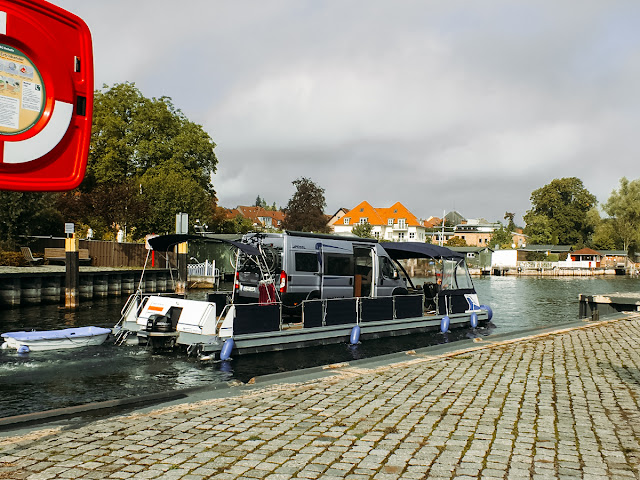















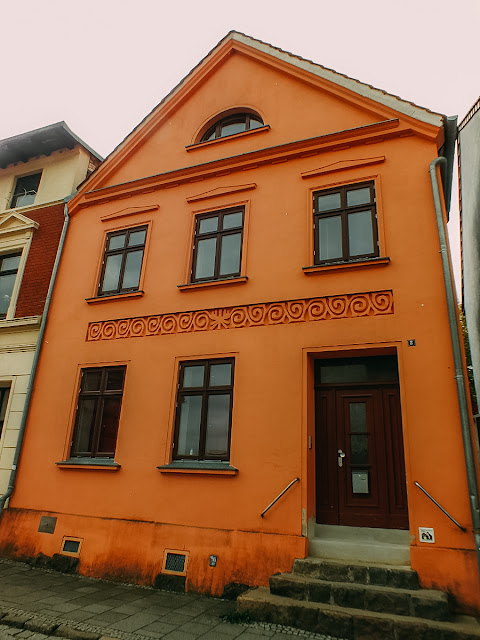





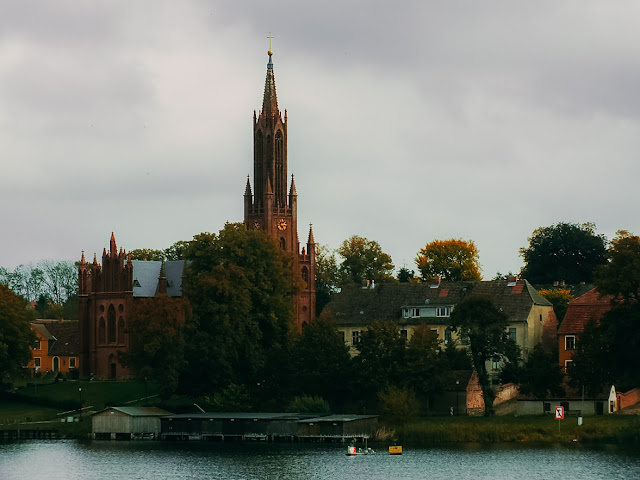













































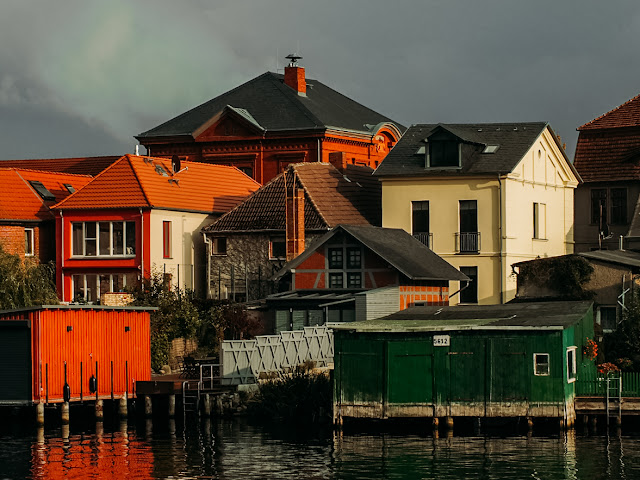




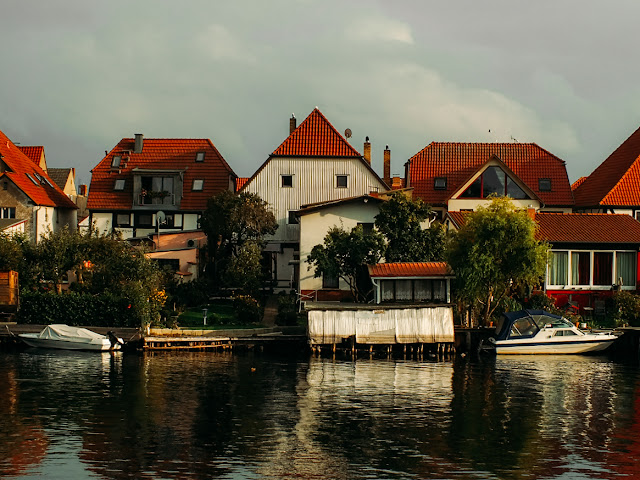
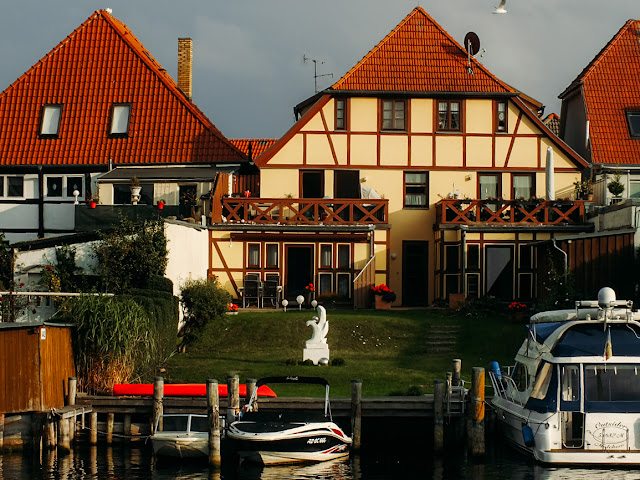



























Comments